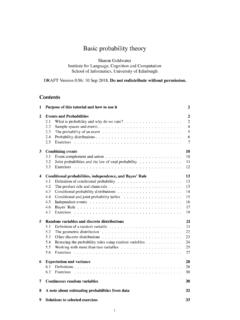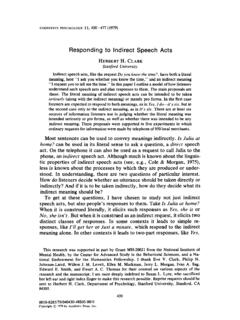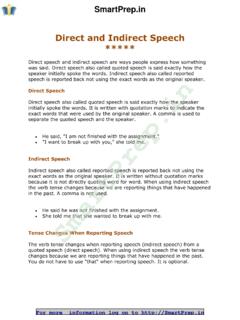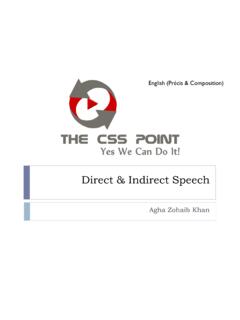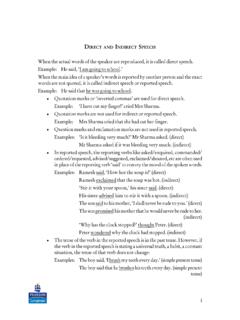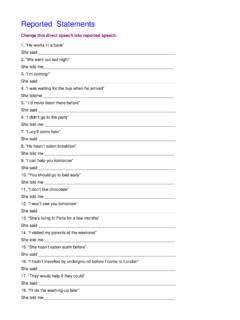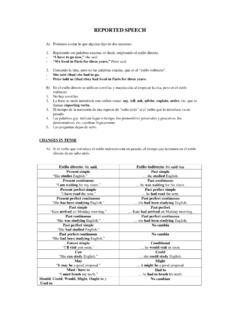Transcription of Indirect Speech Acts - University of Edinburgh
1 Indirect Speech ActsNicholas AsherDepartment of Philosophy, University of Texas at LascaridesDivision of Informatics, University of this paper, we address several puzzles concerning Speech acts , particularly indirectspeech acts . We show how a formal semantic theory of discourse interpretation canbe used to define Speech acts and to avoid murky issues concerning the metaphysics ofaction. We provide a formally precise definition of Indirect Speech acts , including thesubclass of so-called conventionalized Indirect Speech acts . This analysis draws heavilyon parallels between phenomena at the Speech act level and the lexical level.
2 First, weargue that, just as co-predication shows that some words can behave linguistically asif they re simultaneously of incompatible semantic types, certain Speech acts behavethis way too. Secondly, as Horn and Bayer (1984) and others have suggested, boththe lexicon and Speech acts are subject to a principle of blocking or preemption bysynonymy : Conventionalised Indirect Speech acts can block their paraphrases frombeing interpreted as Indirect Speech acts , even if this interpretation is calculable fromGricean-style principles. We provide a formal model of this blocking, and compare it withexisting accounts of lexical IntroductionUnderstanding the motives behind utterances is often crucial to successful the relationship between the surface form of an utterance and its underlying purposeisn t always straightforward, as Searle (1975) shows:(1)Can you pass the salt?
3 Sentence (1) is an interrogative and so expresses a question. Usually, the speaker s goal inasking a question is to get an answer. But (1) plausibly has a different purpose: it s a request,where the speaker s goal is for the interpreter to pass the salt. This is anindirect Speech act(isa), which Searle defines to be an utterance in which one Speech act is performed indirectlyby performing another. With (1), requesting the hearer to pass the salt is performed indirectlyby performing another communicative act asking about the hearer s ability to pass the are puzzling in several respects.
4 First what exactly does it mean for one action to beperformedbyperforming another? Are there in fact two acts here? One act under severaldescriptions? Or one act with several distinct purposes?Secondly, in as much as the semantic type of an utterance determines its linguistic behaviour,the semantic types of someisas are puzzling. On the one hand, there s evidence that someisas, such as (1), behavelinguisticallyas if they re requests: , like other requests, they canbe modified withpleasewhere simple questions can t (Sadock 1974, Horn 1989, Lakoff 1973).(2)a. Could you please pass the salt?
5 B. Please pass the ??Where did you please put the broom?On the other hand, (1) also behaves linguistically like a question, in that a direct answer is afelicitous response (Bach and Harnish, 1979):(3)a. A: Could you please pass the salt?B: Yesb. A: Please pass the : ?? consider questions and requests as not only distinct, butincompatiblesemantic types( , Ginzburg and Sag, 2000). Questions denote a set of propositions ( , its direct answers; , Groenendijk and Stokhof, 1991), whereas requests denote a relation between worlds andactions ( , Segerberg, 1990). As (1) has the linguistic hallmarks of both questions andrequests, its semantic type must be distinct from, but related to, both of these; but it sunclear what its semantic type is.
6 Many otherisas also behave linguistically as if they re two Speech acts in one , involving other kinds of incompatible semantic types. An adequateaccount ofisas must model , the necessary and sufficient conditions for interpreting an utterance as anisaare puz-zling. On the one hand, there s evidence thatisas arise from general principles of rationalityand cooperativity. Gordon and Lakoff (1975), for instance, use Gricean maxims to analyse(1) and (4); Searle classifies (4b) as anisa, sinceBrejects the proposal in (4a) by (4)a. A: Let s go to the movies B: I have to study for an paraphrases to someisas suggest that Gricean inferences aren t always sufficient.
7 Para-phrases typically have the same calculable implicatures. But although replacing (4b) with aparaphrase leaves the communicative act unchanged, (5) shows this is not the case for (1):(5)Do you have the physical ability to pass the salt?1 Principles of rationality and cooperativity are also used within theaicommunity to recognize Speech acts ( , Grosz and Sidner 1990, Litman and Allen 1990).2 Unlike (1), (5) is infelicitous as a request at least in the null context presented here eventhough this interpretation is (1978), Searle (1975) and others conclude from these observations that the calculableisafor (1) is also conventionalized.
8 Horn (1989) and Levinson (2000) go further, and arguethat the difference between (1) and (5) is evidence that Speech acts are subject to a principle ofblocking orpreemption by synonymy: conventionalisedisas can block their paraphrases frombeing interpreted asisas, even if this interpretation is calculable. We agree and argue thatthis view is correct, but this raises puzzles anew: how can a precise model of the interactionbetween conventional and calculable information account for this blocking?Our paper addresses these puzzles by giving a new interpretation of what a Speech acttypeisthat abstracts away from the language of actions.
9 We use a formal model of discourse inter-pretation (Asher 1993, Lascarides and Asher 1993) in which rhetorical structure and lexicaland compositional semantics interact to determine truth conditions and for which we havedeveloped or adapted various technical tools that turn out to be useful here: nonmonotonic ordefeasible reasoning, semantic types and type shifting rules (Montague 1974, Sag and Wasow1999, Pustejovsky 1995, Asher and Pustejovsky 2000). Many Speech act types turn out fromthis perspective to be rhetorical will solve the two Speech acts in one puzzle ofisas by analyzingisas as a particularsort of complex semantic type that s formed from two incompatible types.
10 The constituenttypes of the complex reflect the dual communicative role of anisalike (1). When this dualcommunicative role is conventionalized ( , (1)), an extended notion of grammar assignstheisaa complex semantic type; this then serves to explain why theisabears thelinguistichallmarks of both questions and requests. Otherisas get assigned a complex type on the fly rather than by convention, as a result of pragmatic reasoning and the demands of discourseinterpretation. Roughly, an utteranceuis conventionally assigned one semantic type, buta second semantic type is accommodated in the sense of Lewis (1969), in order to preserveassumptions that the discourse is well-formed or coherent, and that the speaker was ll use our formal tools to analyze blocking at the Speech act level ( , that (1) blocks(5) from being interpreted as anisa, even though this is calculable).





